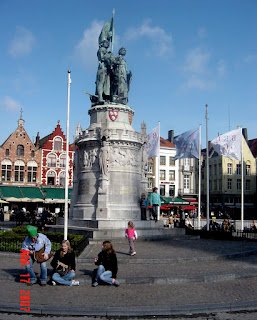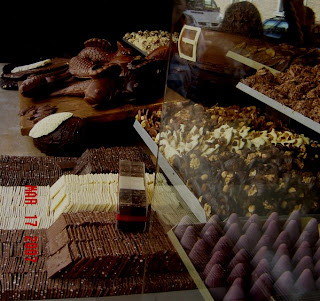What I liked about living in Maastricht in the Netherlands was its location in the southernmost tip of the country bordering Belgium and Germany. Weekend trips to nearby historical towns in Belgium and Germany were common and easily facilitated by the well-networked train system in the region. On a St. Patrick's Day weekend in 2007, we took a 3+hr train ride from Maastricht to visit Brugge (Dutch spelling) in northwest Belgium (the Flemish region of the country).
Beautiful Bruges (the other spelling) has been labeled the "Venice of the North" for her cobbled alleys and many bridges over narrow canals. In 2000, the entire historical city centre was sanctified by UNESCO as a World Heritage site. Many of her medieval architecture still remains intact. Brugge has a long maritime history with trades in Flemish cloth, lace and jewelery amongst the important commodities. Although French is the official language, many of the locals here still proudly (and perhaps defiantly) hold on to their Flemish roots, speaking the local language and embracing their Dutch linkage.
Beautiful Bruges (the other spelling) has been labeled the "Venice of the North" for her cobbled alleys and many bridges over narrow canals. In 2000, the entire historical city centre was sanctified by UNESCO as a World Heritage site. Many of her medieval architecture still remains intact. Brugge has a long maritime history with trades in Flemish cloth, lace and jewelery amongst the important commodities. Although French is the official language, many of the locals here still proudly (and perhaps defiantly) hold on to their Flemish roots, speaking the local language and embracing their Dutch linkage.


Above left: The central monument at the Grote Markt (Big Market Square); above right: The Provincial Court at the Grote Markt


Above left: Church of our Lady Tower in the background
Above right: 'The Madonna and Child' (1504-5) in the Church of Our Lady - Carved in Carrara marble, this was one of the few works by Michelangelo outside of Italy











Life is good here in Bruges. You can whet your appetite at many of Bruges' fine restaurants or satisfy your sweet tooth cravings by sampling some of the wonderful chocolates created by the city's chocolate confectioners (above).
Below are some photos of the beguinage (or 'begijnhof' in Dutch) in Bruges. A beguinage is a dwelling of lay sisters of the Roman Catholic church that is comprised of small houses, with a courtyard in the middle, and enclosed in a wall away from the town proper.









No comments:
Post a Comment